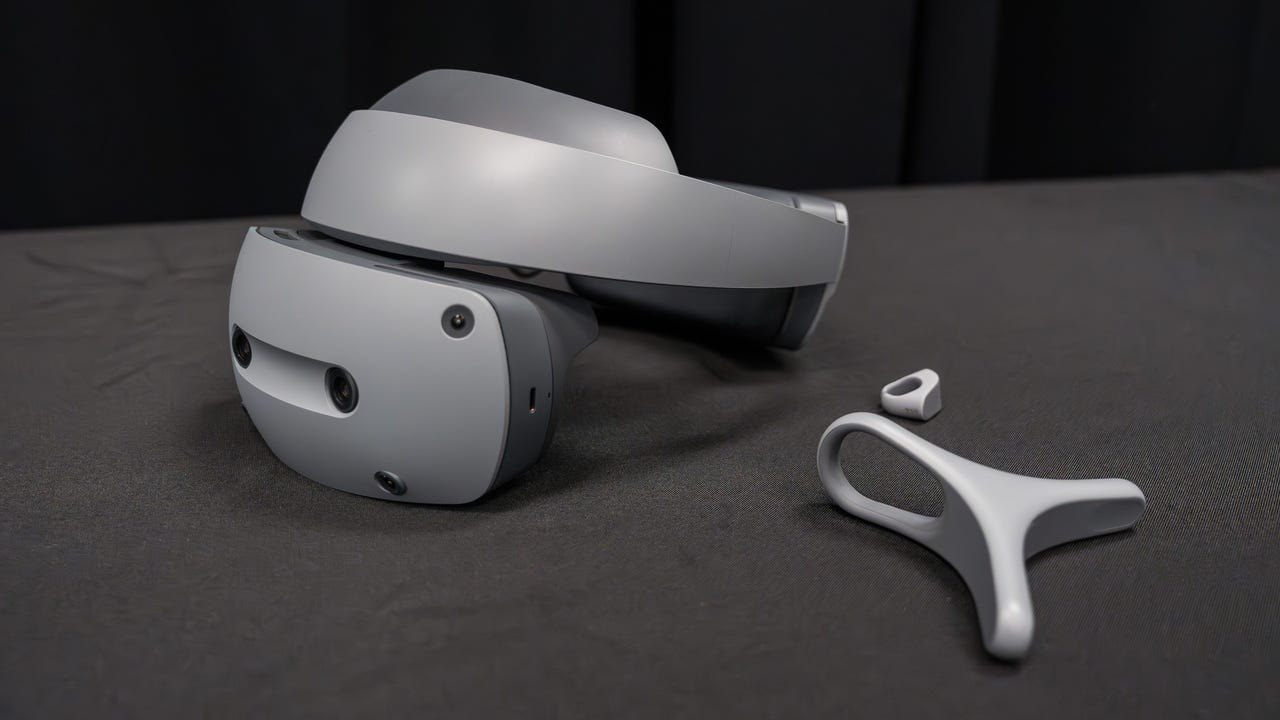
































On the same day Apple announced the release date of Vision Pro, Sony surprised CES 2024 by unveiling a product that no one expected at the world's biggest tech event: a high-end XR headset that rivals Apple Vision Pro in capabilities and design.
This Sony-Siemens head-mounted display will arrive later in 2024 and will feature 4K OLED microdisplays, the new Qualcomm XR2+ Gen 2 chipset, wearable controllers, and a design that has echoes of Sony's PSVR2 but is also unique and attractive with clean curves and a minimalist aesthetic.
Also: CES 2024: What's Next in Tech
sorts through the wave of CES news and announcements to identify innovations that will make the most impact on professionals. Learn about the newest products and trends that transform the future of work and life.
Read nowThe XR headset was unveiled during the opening keynote of CES 2024, delivered by Siemens. As Siemens CES Roland Busch extolled the benefits of the industrial metaverse and "digital twins" for accelerating the future of product development, he welcomed Sony's Yoshinori Matsumoto to unveil the product that would bring Siemens' vision to life.
While Apple Vision Pro has "pro" in the name, it's aimed broadly at consumers and professionals. This Sony-Siemens headset will not be used to watch 3D movies, play immersive games, or meditate in VR on the top of a virtual mountain in Yosemite National Park. However, it could be used to create those kinds of apps and experiences for Vision Pro, Meta Quest, or other headsets.
It will also be used to prototype and design lots of real-world products. It is solely aimed at professionals, engineers, and product designers, and it is meant to be a content creation device that will streamline product development by creating 3D prototypes in virtual environments.
Also: Meet the industrial metaverse: How Sony and Siemens seek to unleash the power of immersive engineering
Nevertheless, the headset clearly has a very thoughtful design that Apple, Meta, and other headset makers could learn from. I've used a lot of different headsets and have already tried the Vision Pro and there are particularly two things I wish Apple's device had to match this Sony XR product.
The first thing I noticed about the Sony headset was the fact that the facial interface and the display flips up and down so that you can easily and quickly jump out of the headset and then jump back in. This is one of the biggest challenges when you're using the Meta Quest 3 and other VR headsets.
The design of the Apple Vision Pro makes it clear that it will have the same issue -- even though Apple's approach is to have high-resolution passthrough so you can interact with your surroundings. With the Quest 3, third-party facial straps like the ones fromBoboVR have become very popular -- especially among VR app developers who regularly switch between their computers and headsets.
However, the Sony headset makes it even more seamless since it was designed from the ground up with this feature in mind (similar to headsets like the Lynx R1, which I also tried at CES). I wish all headsets were designed this way.
Sony XR headset's flip-up facial interface
The Sony headset also features a pair of wearable controllers in the form of a ring and a pointer that have a very futuristic vibe and a practical application for working in virtual spaces. This gets to one of my biggest questions about how well the Vision Pro will work for professionals.
Also: Siemens' CES showcase: Transforming industries with mixed reality, AI, and more
While the Vision Pro's interface is very intuitive, I wonder if hand and eye tracking alone will be precise and efficient enough to use for long periods of time and manipulate 3D models ("digital twins") in virtual spaces. As my friend Scott Stein at CNET wrote about Sony's device, "The headset's ring and stylus/pointer controllers are its most unique features."
At CES, I also tried the Nolo VR Glass and its companion Nolo Air Ring, so I got to see first-hand how useful and natural a ring wearable can be in VR. I'm not suggesting Apple should replace its excellent eye tracking or hand tracking. But there are professional applications like 3D modeling and prototyping where supporting add-on devices similar to Sony's ring and pointer could add to the effectiveness of Vision Pro and make it more ready for extended use in professional environments.
Sony XR headset's wearable controllers -- ring and pointer
To be clear, the Apple Vision Pro will do fine without both of these features. I'm confident that demand for the headset will be off-the-charts and consumers that try it are going to be wowed by the experience -- especially spatial video, spatial photos, and panoramas in spatial computing. It's going to get a lot more people excited about VR, AR, and XR.
Also: The best CES 2024 gadgets you can buy right now
But where these two features matter -- and where Sony got it right -- is when it comes to professionals, developers, and people spending long hours in a headset with a need to be as efficient and purposeful as possible with their time. Those are things for Apple to consider for future versions of the Pro line of Apple Vision.
I used the Lynx R1 headset with its flip-up front visor at the Ultraleap booth at CES 2024.
 Горячие метки:
Наш процесс
Горячие метки:
Наш процесс